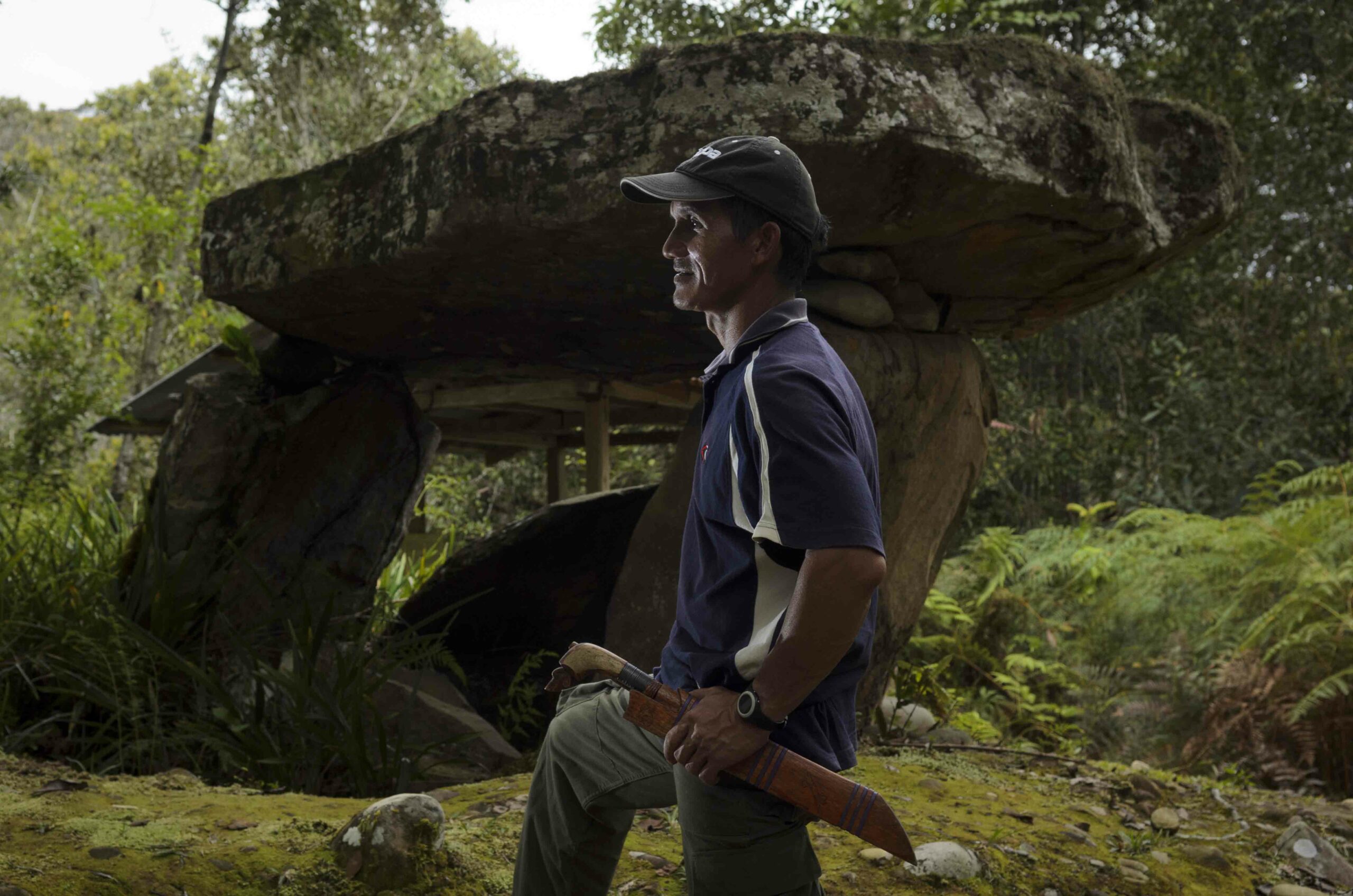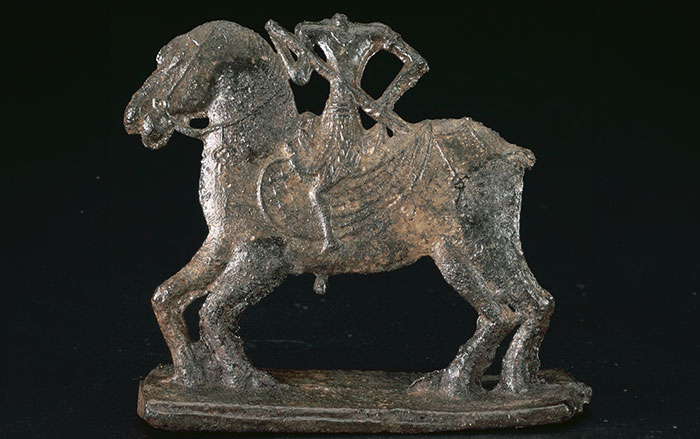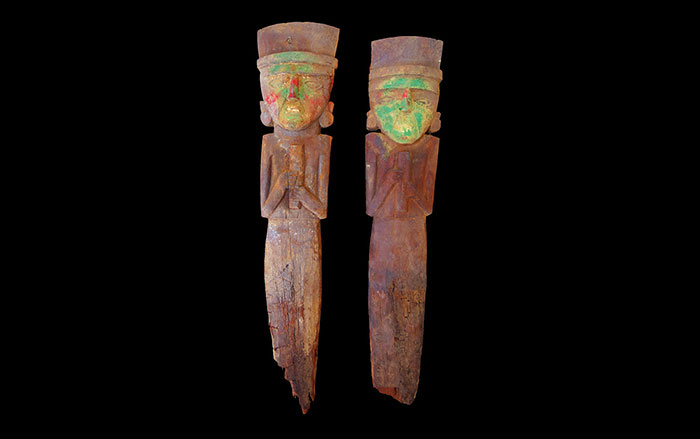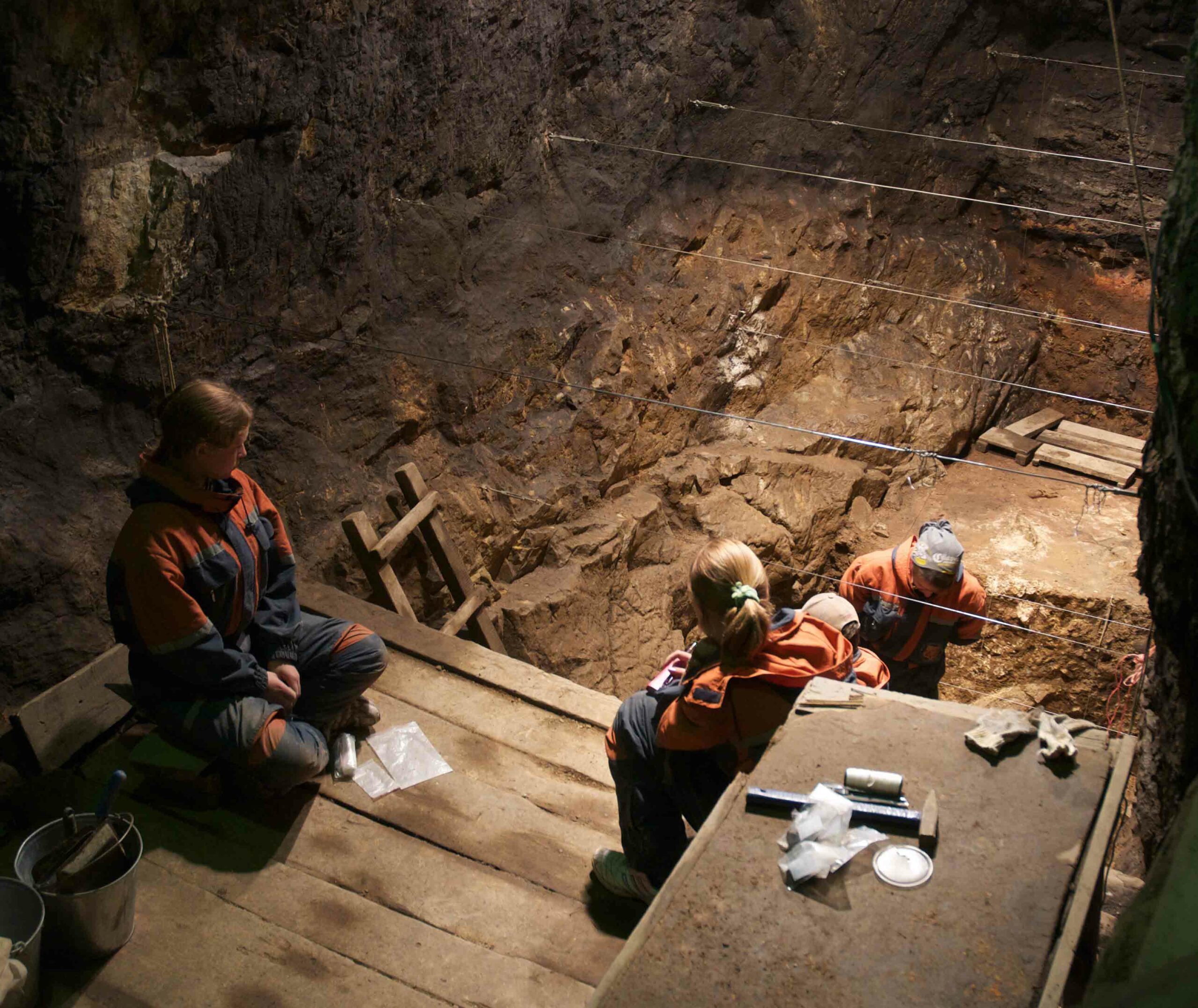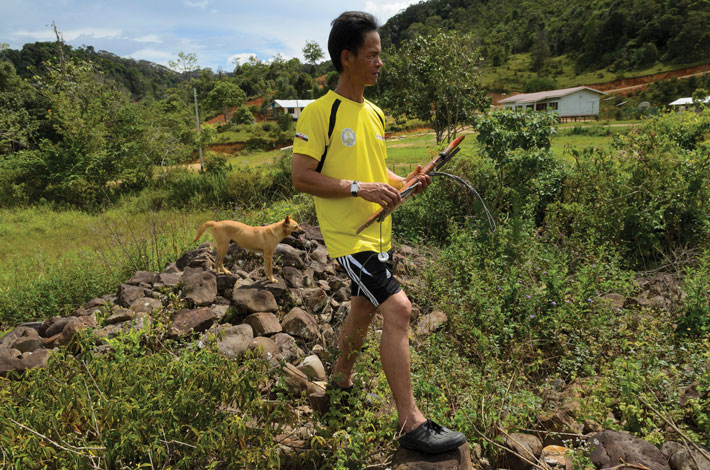
Each day, Henry Lagang heads into the forest to hunt and forage with a machete slung over one shoulder, a gun over the other, and dogs at his heels. His mother grows rice, and so do his neighbors. For generations, people have lived and worked like this to claim the land—and survive—in the inland jungles of Malaysian Borneo.
For centuries, the Kelabits, a small tribe of hunter-farmer-foragers, lived in near isolation in the Bornean forests that straddle Malaysia and Indonesia. The tribe practiced animism and headhunting until missionaries converted them to Christianity in the 1940s. In contrast to the wealth of archaeological and anthropological research on the inhabitants of the island’s coasts, very little is known about the early history of the peoples who dwelled in these highlands. With approximately 6,000 tribe members among a total population of roughly 20 million Borneans, the Kelabits are a tiny minority, and little has been published on their history. But archaeologists working there now may offer new insights into the missing pieces of Kelabit history, as well as that of their predecessors.
Until recently, this region of the island was accessible only by plane or a month-long hike through the jungle. A new dirt logging road now connects the interior and the coast, but the locals who choose to stay still hike far and wide for food. Their lives revolve around the jungle. Kelabits measure their treks in cigarette time, 47-year-old Lagang explains. For example, it’s a “two-cigarette” hike from his mother’s rice field to a recently abandoned longhouse known as Batu Patong, through bucolic fields flanked by thick rain forest resonating with the sounds of insects.

As he heads toward the jungle, Lagang passes a stone mound where local stories say heirless ancestors buried their belongings. Just a few yards away, beside a neighbor’s pineapple garden, sits a broken ceramic jar in what remains of a cemetery. Beyond, the rain forest shelters thousands of years of the archaeological record stacked atop itself, layer upon layer, site upon site: century-old longhouses with fruit trees planted by previous inhabitants, 300- to 600-year-old stone burial jars covered in moss and caked in dirt, now-overgrown rice and sago plots that fed the highlanders up to 2,300 years ago, and even evidence of widespread forest burning, a potential sign of arboriculture, dating back 6,000 years or more. Archaeologists have no way yet to precisely identify many of the jungle’s past inhabitants or the creators of these sites. And the more scientists find, the more questions emerge about the histories that lie hidden.
Though the island of Borneo has 50,000 years of known human occupation, until recently very little excavation, or even survey, has taken place in the inland mountains. Now, research in the Kelabit jungles offers new possibilities for assembling the puzzle of human history across interior Borneo. Since 2007, Lindsay Lloyd-Smith of Sogang University’s Institute for East Asian Studies in Seoul, South Korea, has coordinated archaeological fieldwork for a multiyear, multidisciplinary research team called the Cultured Rainforest Project (CRF). Led by Cambridge archaeologist Graeme Barker, CRF includes scientists from universities and institutes across the United Kingdom, South Korea, and Malaysia, and combines work in the disciplines of archaeology, anthropology, and paleoecology. The project’s aim is to investigate past and present relationships between people and rain forest in interior highland Borneo. “We really didn’t know what to expect,” Lloyd-Smith says of the project’s beginnings. “We now have a pretty good chronological framework for human occupation and subsistence in the heart of Borneo, and it has revealed just how rich and varied the prehistory of central Borneo is. It’s exciting.” Yet the local knowledge of the past on which much of the CRF’s work also depends is slipping away quickly, and documentation of the archaeology might be one of the only ways to save it.

CRF’s work has also given Lagang and his neighbors their first formal chance to learn about Kelabit history, which is not taught in Malaysian schools. And the timing is critical. The last decade has brought rapid change as interior Borneo faces the rise of commercial logging and the cultural changes that come with it. Since 1990, according to a recent scientific report, logging has altered nearly 80 percent of Malaysian Borneo’s land surface. When trees go, so do traditional lifestyles that rely on them. Amid the effects of newly built logging roads, climate change, and a desire among young people for education and city jobs, Kelabit life seesaws between tradition and transition. Fading cultural knowledge compounds the threats to potential archaeological sites from the harsh climate and farmland development, explains Borbála Nyíri, who is Lloyd-Smith’s partner in both life and work, and a doctoral student at the School of Archaeology and Ancient History at the University of Leicester. “Many sites are now only known to a handful of old people, and are quickly dropping out of the sphere of cultural memory,” Nyíri says.
Through the years, Lagang and his mother, Mariar Aran, have opened the doors of their longhouse to researchers—“many people, many times,” Lagang says—offering beds and mosquito nets, meals of homegrown rice, wild boar and deer he has hunted, and vegetables plucked from the jungle. Lagang serves as both host and guide through the tangled terrain.
The Kelabit highlands are dotted with signs of the past. Throughout the forest, there are hundreds of markers called etuu. The Kelabits believe that in order to establish rights over a landscape, it is essential to mark it. These markers can include megaliths, carved stones, stone jars, stone mounds, and even rice fields. One prominent type of mark is the large stone mound known as a perupun. Kelabits today say such mounds, which are found all across the central highlands and can reach 100 feet wide and 10 feet high, were spiritually significant. “These findings seem to indicate a widespread cultural tradition that flourished around 2,000 years ago, during the Early Metal Age,” Lloyd-Smith says. And they indicate use of the landscape going back generations.

Kelabits also see etuu as evidence of a person’s ability to channel lalud, the manifest power believed to govern all nature, from rivers to rain to life itself. Lalud is deeply intertwined with the spirit world, and etuu are indicators of a person’s ties to those spirits and ancestors. According to CRF anthropologist Monica Janowski, “A successful human, of high status, should demonstrate the ability to manage and manipulate lalud effectively, and this should be visible through the etuu marks he or she makes on the landscape.”
Etuu aren’t the only signs of human occupation in the forest. There are also hundreds of old settlements in varying stages of decay. Some are standing wooden structures, such as Batu Patong, while others are recognizable only by fruits and palms planted by previous inhabitants. Some sites date to the 1800s, and locals can remember their names and histories. Others show evidence of occupation dating back 400 years, but nothing is known of the people who lived there. Researchers have also identified what appear to be large, open-air settlements with stone walls and iron artifacts dating to the Early Metal Age, some 1,000 to 2,300 years ago. “As far as I am aware, these represent the earliest Metal Age settlements yet discovered on Borneo,” Lloyd-Smith says. Cave burial sites on the island have been studied before, but much less is known about occupation sites. For the first time, Lloyd-Smith says, he and his colleagues can begin to see these early societies from a domestic perspective, rather than from their mortuary practices alone. But at this point, the researchers don’t know a lot about these sites, such as whether they were long-term villages or gathering points for multiple communities, or how iron tools were introduced, or who brought them.

The evidence uncovered thus far provokes questions about who the jungle’s early inhabitants were, how they lived and worked, what they ate, and how they interacted with their regional neighbors at a time of thriving trade between Borneo, China, India, and Southeast Asia. Were the early inhabitants of interior Borneo indigenous to the highlands, or outsiders who came with iron tools? Were they among the first Neolithic farmers who arrived in Southeast Asia from Taiwan and the Philippines 1,000 years earlier? Or was this interior culture a mix of local development and regional migration?
These queries have led Lloyd-Smith on a new investigation, called the Early Borneo Project. He hopes to focus on the early relationships between Borneo’s highlands and coast, and on the question of whether regional trade could have sparked the construction of megaliths and monuments such as the perupuns in the heart of Borneo in the Early Metal Age. “The effect of such early ‘globalization’ on such distant interior locations has never been considered,” says Lloyd-Smith.
For outsiders, traveling through the Bornean jungle is a constant challenge of balance, strength, and determination. But Lagang knows this place, how it behaves, and how he must respond. Even fording rivers is routine for him. He braces his body against the forceful flow of cold water rushing over rocks. Once across the water, he bushwhacks through vines and leaves, clearing a path to Long Diit, a site that was a settlement 1,000 to 2,400 years ago, and was later used as a cemetery, or menatoh, likely beginning 300 to 600 years ago. Menatoh are found throughout the highlands. These were essentially “villages of the dead,” according to Janowski. There, the deceased continue to live in the parallel spirit world or dimension, growing rice, keeping chickens, and practicing other everyday activities.
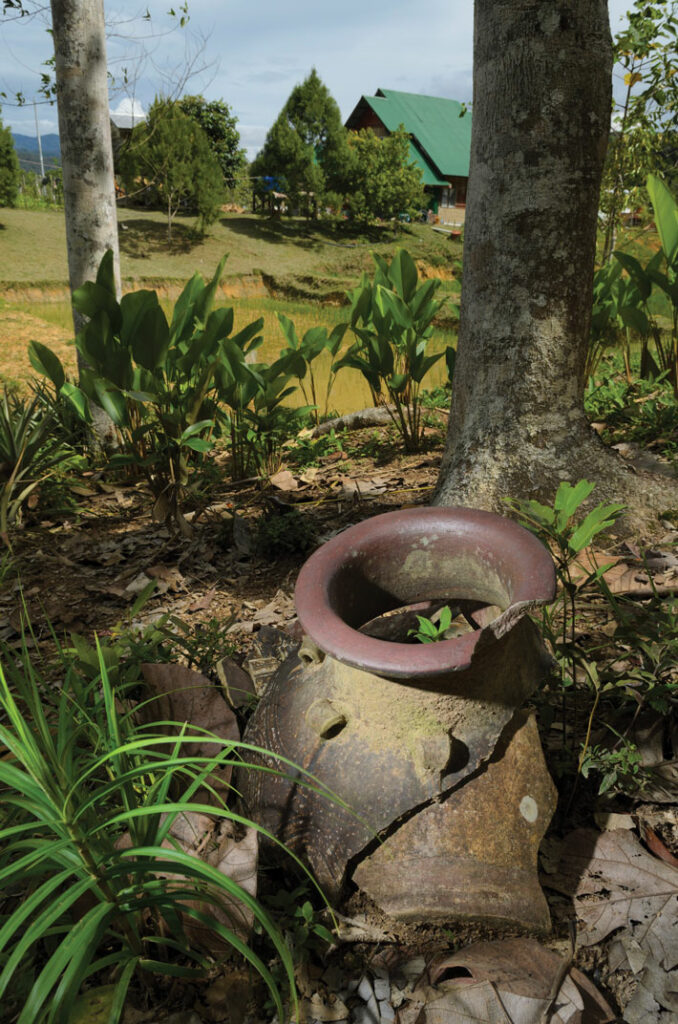
At Long Diit, beneath the towering canopy of old-growth forest, are seven slab structures and 14 moss-covered stone burial jars, some standing, some fallen, some broken. The intact jars are the size of a small, slim person. The area was used as a burial ground before the Christian conversion, Lagang says. Pointing to a giant tree with gnarled roots, he recalls the skulls—“a lot of them”—that used to sit at its base when he was a child. Wherever you see this type of tree, he says, ancestral remains may lie beneath.
Stories like Lagang’s are critical to understanding the region. Sometimes, local legends are the very foundation from which researchers work.
Another type of historical evidence, large glazed stoneware storage jars, were likely first produced in China in the seventh through tenth centuries, and became highly prized trade items in Borneo, according to Nyíri. In the Kelabit highlands, these jars—known as dragon jars for the designs that typically adorn their sides—were keepsakes, or were used for rice or wine. Others were used for storing the bones of the dead in pre-Christian cemeteries. “Dragon jars became treasured heirloom pieces passed down for generations,” Nyíri says. Only the wealthy upper classes owned them, and some Kelabit elders still keep these jars in their homes. “They put rice inside,” says a 43-year-old villager named Walter Paran, describing the jar his family bought, long before he was born, from traders across the border in Kalimantan for the price of two buffalo. Today Paran takes care of several jars that his uncle, now deceased, kept in his house. His living relatives don’t know much about them, their origins, or their value. “We forgot to ask,” he says. “That’s a big mistake for us. That is why we are losing our history …that’s why our children, they don’t know.” He’s happy the CRF team is taking notes and recording data. Paran, like many elders, says Kelabit history is fading from memory. His nine-year-old daughter, Mujan, and her peers trek five hours to the town of Bario, where they attend boarding school. In class, they learn nothing about the Kelabit culture. “They teach history,” Paran says, “but not this type of history.”
When Lagang was a child, several dragon jars sat at the edge of his village, right above a river. Only the pieces of only one remain today. He recalls that when he was a young boy, he approached that place with caution because the jars held spirits that sometimes spoke—a story repeated by Kelabit elders across the highlands. “Ting, ting, ting … whoo whoo,” he mimics the voices. When he heard that, he ran away fast, he says. It’s been a long time since the spirits have spoken to Lagang.

Both Kelabit villagers and CRF researchers hope their collaboration can help fill the knowledge gap. “We have always been warmly welcomed, looked after, and supported, even adopted,” says Nyíri. She feels a responsibility in return, and a duty to inform. “We hear complaints that researchers collect data, publish it, and make a career out of a few months’ work,” without sharing their findings with local communities, she says. To remedy that, the archaeologists have exhibited their findings, tools, and future research plans for local audiences. The CRF has published annual reports in the Sarawak Museum Journal and distributed project pamphlets throughout the highlands. “It’s only ethical and fair to share even preliminary results with the local community,” Nyíri says.
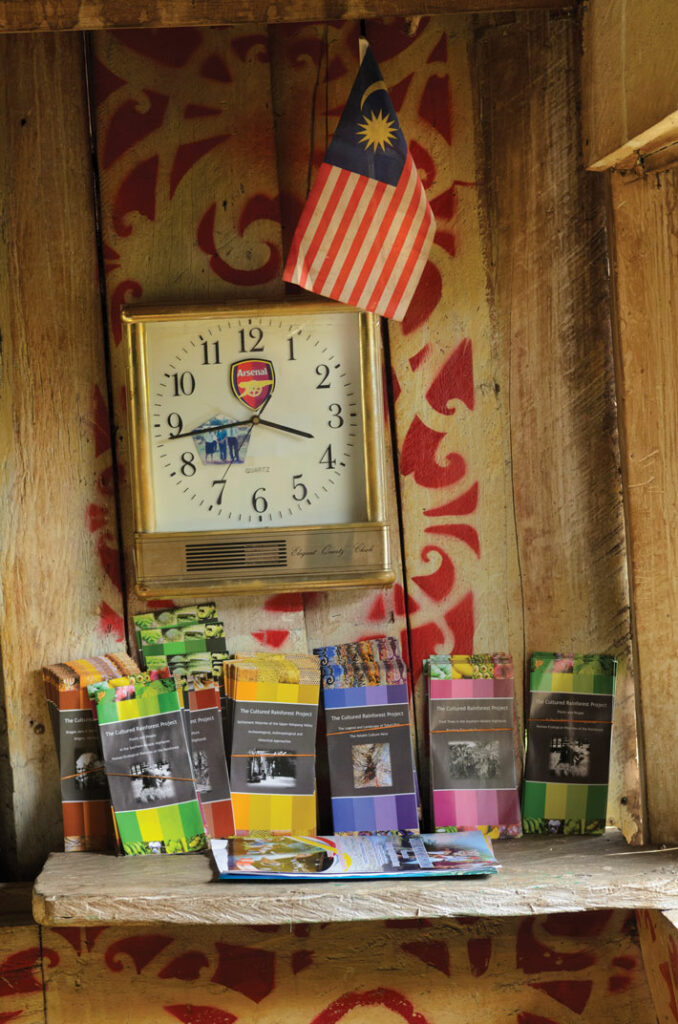
It’s also what locals crave. “I’ve been interviewed many, many times, but I haven’t seen the results before,” says an elder named Jenette Ulun, who is active in Kelabit festivals and whose name often appears on travel blogs as an authority on Kelabit cultural traditions. “It’s good to finally know the results,” says Ulun. “It’s not only for us to see. Now our children can see this is what’s done for the Kelabits, for our people, and understand our culture and know what their parents, their grandparents, their great-grandparents did. Otherwise there is no written record.”
That record is critical in the fight to preserve local heritage. “‘Rural development’ is the buzz phrase in Sarawak these days,” says Lloyd-Smith. The term encompasses everything from palm oil and rubber plantations that replace rain forests after logging, to agricultural projects and homestay tourism. “Within such an environment,” he says, “only by the community realizing the cultural value of their archaeology, and being proud of how important it is for Borneo and the whole of Southeast Asia, can the protection of the cultural heritage of the Kelabit highlands be safeguarded. Archaeology can play a large role in this.”
One day, Lagang stands atop a perupun just a few hundred yards from his longhouse. From this vantage point, he looks to the past. “Before, when I was small, this was all jungle,” he says, gazing at his neighbors’ homes and vegetable gardens. Lagang used to hunt birds with his blowpipe right around here. Life was a bit different then. More people lived in the longhouse, gathering in the evenings and early mornings around smoky open fires in the communal hallway that traditionally connected one Kelabit family to dozens of others. It was a close, collective existence. But these days, many permanent village residents opt for individual family homes. Modern houses with metal roofs have sprung up around the perupun where Lagang used to hunt. Rice paddies and gardens sit where trees once stood. Though jungle still surrounds the village, times have changed, and so has Kelabit culture.

At sunset, Lagang works in the longhouse kitchen, preparing a dinner of paddy rice, fried pork fat, bamboo shoots, and mouse deer soup—all harvested from the forests that feed him every day, the same forests that fed millennia of highlanders. That evening, he shows snapshots of the researchers who have stayed with him through the years. When dinner is finished and the dishes are cleaned, Lagang sits alone beside the open-hearth fire, staring into the night. It’s Sunday, the last evening of a weeklong holiday. Almost all the young adults have returned to school and work in the city. Just a few elders sit and chat on the wobbly wooden floor planks, 300 feet away from Lagang, at the end of the longhouse. The lights are out, and the lengthy common corridor ends in blackness. How long will this longhouse last? How long will the Kelabit forest and the archaeological sites within it endure? Will the Kelabits have a chance to learn their own history before it disappears? Ties to the ancestral past, imprinted in stone and carved into the land, still bind the Kelabits today. The perupun Lagang remembers as a child remains intact, undisturbed. He’s happy the archaeologists are studying it. “They write the story about the Kelabit people. They can protect the megaliths, the culture,” he says. “Good.”


